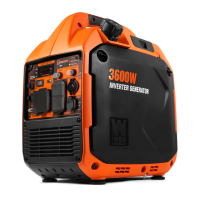STARTING YOUR GENERATOR
BEFORE STARTING THE GENERATOR
1. Verify that the generator is outside on a dry, level surface. Allow at
least two feet of clearance on all sides of the generator.
2. To maximize safety, check that the generator is properly grounded.
See page 14, “Ground the Generator.”
3. Check that there is a sufficient level of oil in the crankcase. Add oil
if necessary. Refer to page 12, “Step 1 - Add / Check Oil.”
4. Check that there is a sufficient level of fuel in the fuel tank. Add gas
if necessary. Refer to page 13, “Step 2 - Add / Check Fuel.”
5. Make sure all electrical devices are unplugged from the generator
during ignition. Otherwise it will be difficult for the engine to start.
STARTING THE GENERATOR
1. Place the generator outside on a dry, level surface. Allow at least
two feet of clearance on all sides of the generator.
2. Check there is sufficient level of oil in the crankcase. Add oil if
necessary (refer to “Add / Check Oil” on page 12).
3. Check there is sufficient level of gasoline in the fuel tank. Add fuel
if necessary (refer to “Add Gasoline” on page 13).
4. To maximize safety, make sure the generator is properly grounded
(refer to “Ground the Generator” on page 14).
Fig. 6
Fig. 7
Fig. 8
16
1
1
5. Make sure all electrical devices are unplugged from the generator during ignition. Otherwise it will be difficult for
the engine to start.
6. Turn the ECO-MODE switch to “OFF” during starting (Fig. 6 - 1).
7. Turn the 4-in-1 switch (Fig. 7 - 1) to the “CHOKE” position.
8. Pull on the recoil starter handle (Fig. 8) slowly until a slight resistance is felt, then pull quickly to start the engine.
Return cord gently into the recoil starter. Never allow the cord to snap back.
9. Turn the 4-in-1 switch (Fig. 7 - 1) to the “RUN” position.
10. Allow the engine to run for several minutes before attempting to connect any electrical devices. This allows the
generator to stabilize its speed and temperature.

